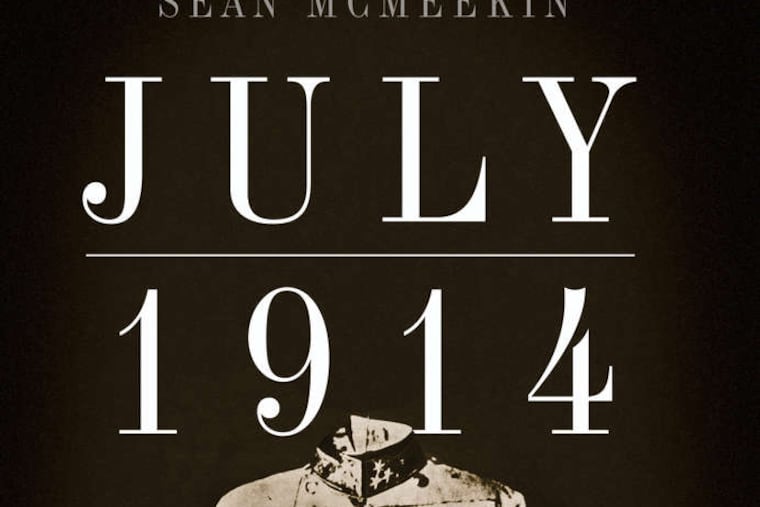Historian apportions blame for WWI
World War I was the hinge of the 20th century. Much of the rest of this most savage of centuries had its roots in the incredibly destructive conflict that killed 10 million and wounded 20 million.

Countdown to War
By Sean McMeekin
Basic Books. 461 pp. $29.99
nolead ends nolead begins
Reviewed by John P. Rossi
World War I was the hinge of the 20th century. Much of the rest of this most savage of centuries had its roots in the incredibly destructive conflict that killed 10 million and wounded 20 million.
Without World War I, World War II would be inconceivable. It is equally difficult to imagine the Russian Revolution or the rise of Adolf Hitler without the social and economic chaos that World War I brought about.
Because of its significance, World War I has generated an enormous body of literature, one that is sure to grow next year as the centenary of the war arrives. Among the questions that have fascinated scholars, and those just interested in the war, is who bore the ultimate responsibility for the outbreak of the conflict.
The Versailles conference that ended the war assigned sole blame to Germany, a grossly unfair conclusion that those who study the war have quickly rejected. Now, a new study, July 1914: Countdown to War, by a young, talented historian, Sean McMeekin, seeks to resolve this matter by focusing on the actions of the Great Powers in the weeks after the assassination of Archduke Francis Ferdinand on June 28, 1914 by young Serbian nationalists.
July 1914 takes the reader day by day, at times hour by hour, through the last days of peace in what McMeekin calls "the Indian summer of old Europe."
McMeekin is scrupulously fair and judicious in assigning blame. He starts by demonstrating the complicity of the Serbian government, including its prime minister, in the plot to kill Francis Ferdinand. Austrian authorities, led by Foreign Minister Count Berchtold, decided to use the assassination as a pretext to cripple Serbia once and for all.
McMeekin is harsh on Berchtold and what he labels the "ineptitude" of Austrian authorities during the weeks leading up to war. He is equally harsh with the German leaders, especially Chancellor Theobald von Bethman-Hollweg and Kaiser William II. Fearing to see their only ally, Austria, weakened, they gave Berchtold a "blank check" by effectively endorsing Austrian actions against Serbia.
This started a chain of events that soon spun out of control. The Russians, not wishing to see their Serbian allies humiliated, warned the Austrians to back down. The Austrians appealed to Germany to support them, and the rush to war was on.
The Russians, who had experienced a series of diplomatic setbacks in recent years, were determined to seek revenge on their enemies, particularly Austria. In McMeekin's view, Russian Foreign Minister Sergei Sazanov bears a heavy responsibility for pressing for an attack on Austria even as it led to a war with Germany.
France, an ally of Russia, saw an opportunity to weaken its archenemy Germany and urged the Russians to take action. By the time Britain became involved in the crisis, Foreign Minister Sir Edward Grey was unable to create momentum for a conference to mediate the crisis.
The complexity of modern warfare, with its time-sensitive war plans, eventually brought Britain into the war against Germany. The German offensive, the Schlieffen Plan, required Germany to breach Belgian neutrality - a neutrality guaranteed by all the Great Powers. The British viewed any attack on Belgium as a potential threat to English security. As Napoleon had observed in a previous era, Belgium was a pistol leveled at the head of England.
In many ways, Europe, which had experienced more than four decades of peace, drifted into war without grasping its consequences. No one in 1914 had any conception of what a modern war would be like. Given the changes in technology that had taken place in recent years - including machine guns, poison gas, modern rifles, and airplanes - the bloodletting of a Europe-wide conflict would dwarf the carnage of past wars.
While the complexities of the various alliance systems bear heavy responsibility for bringing the Great Powers to war in 1914, McMeekin concentrates on the incompetence of the major statesmen - Berchtold, Sazanov, French President Raymond Poincare, and Bethman-Hollweg - for allowing the July crisis to escalate. While there is an element of great tragedy in the way these statesmen blundered into a war, McMeekin insists they "oozed with malice as they rigged the decks for war."
McMeekin has written a fascinating and original study of the opening stages of World War I, a book that supersedes, in my view, any previous study of that great topic.